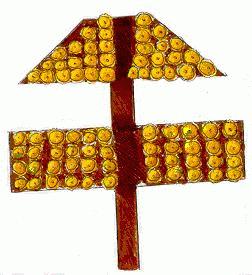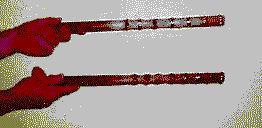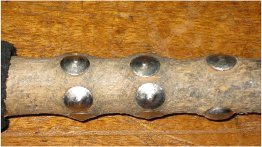

 |
Rattlers |  |
~~~~~~~~~~~~~~~~~~~~~~~~~~~~~~~~~~~~~~~~~~~~~~~~~~~~~~~~~~~~~~~~~~~~~~~~~~~~~~~~~~~~~~~~~~
|
I am still experimenting with rattlers. My early versions were whittled out of soft wood and I found they soon wore out. My current rattler - the one I use with the large lagerphone - has been made for me by Colin Samundsett out of yellow box (Eucalyptus melliodera, a premier honey producer in New South Wales, so he tells me) which is a hard wood and consequently it is lasting much better. In section it is rather more than 1" square at the notches end and 1½"x1½" at the handle end. Thus it is bigger and heavier than most rattlers but I am finding it suits me. Colin has also designed it so that I can balance the handle under my forearm and thus in profile it has a rifle shape. The notches themselves are about 1" apart and about ½" in depth. The ridges between the notches have been levelled off to be about ½" wide and thus the rattler rides across the pole producing more of a rumble than a stutter. All this is experimental but seems to be producing good results. Other rattlers I have noticed vary as much as do the lagerphones themselves and commonly are made from a handy piece of scrap wood rather than being carefully carpented. I remember meeting Noel Harrington one year at Major's Creek who cheerfully told me that he whittled a new one whenever he needed it. He followed his band round on a motor cycle and his lagerphone consisted of two short poles which he joined together to make one long pole by means of a metal socket. Thus he could strap the two pieces one each side of the bike when he set off again. Unique among the lagerphones I have encountered. But then just about every lagerphone is unique!
This one below goes with the 'red box' lagerphone in the Examples page and is made from the same wood. Being round it strokes nicely through the upper cleft in that lagerphone. But notice how worn it has become through repeated use !
|
 |
||
 |
~~~~~~~~~~~~~~~~~~~~~~~~~~~~~~~~~~~~~~~~~~~~~~~~~~~~~~~~~~~~~~~~~~~~~~~~~~~~~~~~~~~~~~~~~~
|
The rattlers used by the Currawong bush band in Sydney. In this case, instead of cutting notches, Currawong have hammered upholstery tacks around the stick. This gives much more durability and a smoother ride of the rattler over the lagerphone. But obviously such tacks would chew away at bare wood so they put around the pole the metal sheathing you saw in the Examples page. The rattler itself still wears, and Don Richmond, the Currawong lagophonist, finds that eventually they break between the ring of tacks closest to the hand grip, or the next gap further away. Don also mentions that he once calculated that in a four hour bush dance he played on his lagerphone over 8000 main beats.
|
 |
~~~~~~~~~~~~~~~~~~~~~~~~~~~~~~~~~~~~~~~~~~~~~~~~~~~~~~~~~~~~~~~~~~~~~~~~~~~~~~~~~~~~~~~~~~
| And the same idea again with the rattlers used by Walter Bollinger of the the Ryebuck bush band in Sydney.
|
 |
|
 |
~~~~~~~~~~~~~~~~~~~~~~~~~~~~~~~~~~~~~~~~~~~~~~~~~~~~~~~~~~~~~~~~~~~~~~~~~~~~~~~~~~~~~~~~~~
 |
The Wacker : the rattler used by the Bushwahzee Band from Melbourne is an axe handle cut into three notches each approximately half a handle deep and 3" apart from dip to dip. The ridge between each is about 1" wide to avoid chipping'. |
~~~~~~~~~~~~~~~~~~~~~~~~~~~~~~~~~~~~~~~~~~~~~~~~~~~~~~~~~~~~~~~~~~~~~~~~~~~~~~~~~~~~~~~~~~
 |
 |
|
|
Two views of the rattler used by the Franklyn B. Paverty band. It is the handle from a small sledge hammer sawn into and then cut at a slant to remove a v-shaped piece. A sledge hammer handle was used because an axe handle had been found to not be hard enough.
|
||
~~~~~~~~~~~~~~~~~~~~~~~~~~~~~~~~~~~~~~~~~~~~~~~~~~~~~~~~~~~~~~~~~~~~~~~~~~~~~~~~~~~~~~~~~~
 |
 |
 |
 |
 |